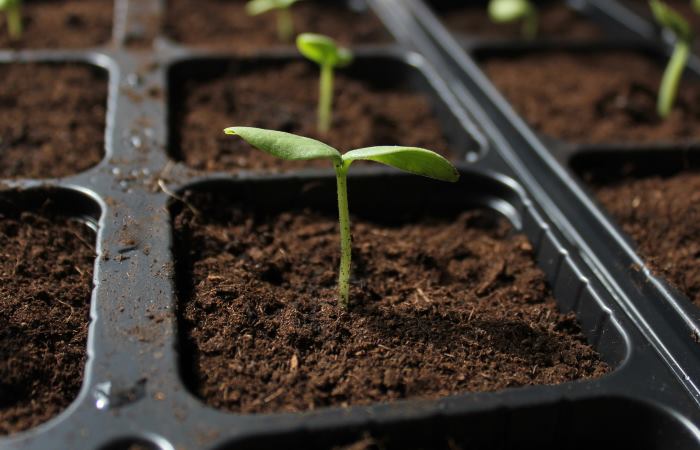Watering your plants the right way is crucial to keeping them healthy, especially when they start from seed.
If you give your seedlings too little water, they’ll wilt and die or even fail to germinate. Give them too much water, and they might rot, drown, or fall over if the water pressure is too strong.
Whether you’re starting your seeds indoors or sowing them directly outdoors, giving them just the right amount of water is what will determine if your plants produce a good harvest or die before their first flower even blooms.
It can be difficult to tell whether your seedlings need water or not, and how to water them correctly.
Follow our guide below to ensure your seedlings get all the hydration they need to become productive members of your garden.
How Often To Water Seeds
Make sure to water your garden plot or your seedling tray before planting. This will ensure that your seeds have all the moisture they need around them as they start to grow. Seedlings need a growing medium that’s constantly moist as they can’t survive long without water.
The best indicator that your seeds or seedlings need water is how dry their growing medium is. When you touch the soil, it should neither feel soggy or too dry. Instead, it should feel like a moist sponge.
Too much water can promote diseases, pests, mold growth, and other problems that can kill your plants. If the soil gets too dry, your seedlings won’t get the moisture they need to grow, and they’ll begin to wither away.
Once a seedling dries out, it won’t always bounce back after watering the way mature plants do. That’s why it’s better to keep them healthy in the first place.
When growing your seedlings indoors in flats, you should check on them a few times a day. Touch the top of the soil to test for moisture. If it feels like it’s beginning to dry out, it’s time to water.
The bigger your seedlings get, the more water they’ll need. So make sure to check on them often.
When direct sowing seeds outdoors, you should still check in on them a couple of times a day. One inch of rain is usually enough for outdoor plants, but if your area isn’t getting enough rain, you may have to supplement with some watering.
Put your finger an inch or two into the soil. If it feels dry, give them some water. If the soil feels moist, leave them alone.
As outdoor seedlings stretch into the soil to find water and nutrients, their root system is strengthened, helping them grow stronger. This is why it’s not as important for the soil right on top of outdoor seedlings to be constantly moist, the way it is for indoor seedlings.
You can also purchase an inexpensive soil moisture gauge that will tell you exactly how much moisture is in your soil.
Bottom Watering VS Top Watering
There are two main ways to water indoor seedlings: from the top or the bottom. Each method has its benefits, but bottom watering is usually preferred, especially for small, delicate sprouts.
Top watering involves watering your seeds and seedlings from the top. This method is used to keep your soil moist before your seeds germinate, but it can also be used for larger, more established seedlings.
Bottom watering is the most gentle and easiest way to water seedlings but requires the use of a self-watering seed tray. The good news is you can purchase these or make them yourself.
It uses capillary action, or the wicking of water from areas of higher water concentration up to areas of lower water concentration, to keep your seedlings’ growing medium moist with minimal effort on your part.
How To Water Seedlings
How you’ll water your seedlings will depend on which system you choose to use, but both methods are fairly straightforward. Here’s an overview of how to get started with each method:
Top Watering
When top watering your seedlings, use a mister or a very gentle spray bottle to water the top of your sprouting tray. You can also make your seedling watering can by poking tiny holes into a water bottle cap or other small container.
Essentially, you just have to ensure that the flow of water is very slow and gentle. Otherwise, your seedlings can easily get knocked over.
Check on your seedlings a few times a day and water as needed. It’s also recommended to cover your seedlings with a humidity dome to preserve as much moisture during the germination process.
Bottom Watering
Bottom watering your seedlings requires you to buy or set up a self-watering system. You’ll have to place your cell tray or seedling containers into a flat tray.
Add enough water to the flat tray so that about one-quarter inch of the bottom is covered with water once the seedling tray is placed in it. The water will soak up through the bottom of the seedling cells and keep the seedlings’ soil moist.
You’ll have to check the water level around once a day and add more water as needed. You’ll still want to use humidity domes until the seeds germinate to keep as much humidity in the soil as possible.
In Summary
When you’re sprouting your seedlings, giving them the right amount of water at this crucial stage can often be what makes or breaks your efforts to raise plants to maturity.
Knowing how and when to water your plants will ensure that those little babies you’ve sprouted will grow up to become vigorous growers and produce beautiful blooms and delicious fruits and vegetables.
Whenever possible, water your seedlings with room temperature water so as not to shock your sprouts with water that is too hot or too cold.
Although not every plant has the same needs when it comes to watering, by following the tips outlined here, you can ensure that your seedlings get off to a strong and healthy start.











